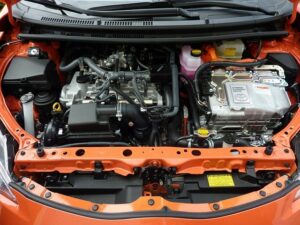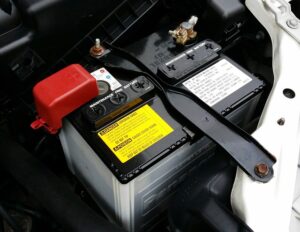Introduction – Rationale for Reconditioning Lead Acid Battery
[Update 03/05/2024: we updated the article to include a section of what are signs that a battery benefits from reconditioning.]
To start, let us emphasize that we’re not auto experts, only amateurs who are interested in carbon reduction and reducing waste. The advice below is a result of our research and is for educational purposes only!
So we’re going to talk about old combustion tech – lead acid batteries. Lead acid batteries store electricity and are used for starting the car as well as provide electricity. They are recycled 99% of the time. In the spirit of ShrinkThatFootprint, consider reconditioning a battery that’s completely dead.
Instead of replacing your car battery, reconditioning it will save you money and also help the environment by reducing waste. In this post, we will talk about reconditioning lead acid battery.

More About Lead Acid Batteries
Vehicles with an internal combustion engine have a battery that provides electrical power to start the engine.
The battery also powers the lights, radio, and other accessories when the engine is turned off.
A car battery typically lasts four to five years and will lose its charge over time. When this happens, the battery needs to be replaced or reconditioned to work properly.
A dead battery can cause several problems, including a clicking noise when you turn the key in the ignition, dim headlights, and slow engine cranking.
If your battery is over three years old, it’s a good idea to have it tested to see if it needs to be reconditioned.
What Is Battery Reconditioning?
In simple terms, it is restoring a battery to a near like-new condition. Reconditioning helps to restore the cells to their original condition, allowing the battery to once again deliver peak performance. You can do this with most types of batteries, including lead-acid, nickel-cadmium, and lithium-ion batteries.
Reconditioning involves cleaning the battery cells, fully charging and then discharging the battery, and then recharging it to 100%. Doing this can significantly extend the lifespan of a battery.
Not only does reconditioning prolong the life of a battery, but it can also improve its performance. When a battery is first manufactured, its cells are full of energy and can deliver peak power.
However, the cells become damaged and degraded over time, resulting in a loss of capacity and power.
Reconditioning batteries has many benefits, both for individuals and businesses. For individuals, it can save money by prolonging the life of their existing batteries.
For businesses, it can lower operating costs by reducing the need to replace batteries as often. And for everyone, it helps to reduce electronic waste and environmental pollution.
Can Lead-Acid Batteries Be Reconditioned?
The answer is yes, but it’s important to understand how the process works before attempting it. Lead acid batteries use a chemical reaction to convert stored energy into electrical energy.
Over time, these chemical reactions can break down the battery’s internal components, causing it to lose capacity. However, through a process called reconditioning, it is possible to restore a lead acid battery to its original condition.
Reconditioning involves running a current through the battery to trigger a new chemical reaction that reverses degradation effects.
As a result, reconditioned lead acid batteries can provide the same level of performance as new batteries. While the process is not particularly difficult, it requires specialized equipment and knowledge. As such, it is best left to experienced professionals.
When to Consider Reconditioning Your Lead-Acid Battery
If you’ve noticed that your vehicle’s battery isn’t performing as well as it used to, it might be time to consider reconditioning. Some signs that indicate your battery could benefit from reconditioning include slow engine cranking, dimming headlights, or the need for frequent jump-starts.
If your battery is more than three years old and you’ve experienced these issues, reconditioning could help restore its performance and extend its lifespan. However, if your battery is older than five years or has been deeply discharged multiple times, reconditioning may not be as effective, and replacement might be necessary.
If you’re unsure whether reconditioning is the right choice for your battery, consult with a professional or have your battery tested to determine its condition.
Tips For Reconditioning Lead Acid Batteries
The process of reconditioning a lead acid battery is conceptually not hard. It involves restoring the battery to its full capacity by recharging it fully and then discharging it completely.
You can repeat this process several times until the battery is restored to its original condition. There are a few important things to remember when reconditioning a lead-acid battery.
Section 1: Safety Measures
Always wear gloves and safety goggles when working with batteries, as the acid can be harmful. Make sure you’re working in a well-ventilated area.
Section 2: Desulfation Process
Rationale
Desulfation is the first and most crucial step in reconditioning a lead-acid battery. It addresses the root cause of the battery’s reduced performance, which is the sulfate build-up on the battery plates. Exciting research indicates there are material additives to improve performance but that’s not in the scope of our article.
Methods
- Chemical Method: You can use a chemical desulfator available in the market to dissolve the sulfate crystals. These are also called “Battery De-Sulfater Battery Additive”. Follow the manufacturer’s instructions for the best results.
- Electronic Method: Alternatively, you can use an electronic desulfator that sends high-frequency pulses through the battery to break down sulfate crystals. Good features include auto detection of battery voltages. It won’t work for all batteries – effective for batteries up to three years old and specifically suited for storage batteries and winter maintenance.
Section 3: Cleaning The Battery
Clean the battery terminals with a wire brush. This will remove build-up of corrosion that prevents electrical contact.
Section 4: Verification Of The Voltage
Next, check the battery voltage with a voltmeter. The ideal voltage for a lead acid battery is 12.6 volts. If the voltage is below this, it needs to be recharged.
Section 5: Recharging The Battery
Next, recharge the battery using a slow charger. This will help to avoid damaging the cells. The ideal charging voltage for a lead acid battery is 2.4 volts per cell.
For instance, when reconditioning a 12-volt battery, which typically contains 6 cells, you would charge it at 14.4 volts (2.4 volts x 6).
Once the battery is fully charged, allow it to rest for 24 hours before continuing.
[Note: many thanks to a reader who pointed out an error in our earlier text that suggested an incorrect, much higher and potentially dangerous charging voltage.]
Section 6: Discharging The Battery
After resting, discharge the battery completely by connecting it to an electrical load.
This can be done by connecting a light bulb or resistor across the terminals.
The load should be around 50 watts for a 12-volt battery. Allow the battery to discharge until the voltage drops to 10.5 volts.
Section 7: Repeating The Process
Repeat the charging and discharging process two more times. This will help to restore the capacity of the cells.
After the third cycle, you should return the battery to normal use.
These steps will help you recondition your lead acid battery and prolong its life. Always wear gloves and safety goggles when working with batteries, as the acid can be harmful.

What To Watch Out For In Reconditioning A Lead Acid Battery
If you’re considering reconditioning a lead-acid battery, there are a few things you need to keep in mind.
First, wearing protective gear such as gloves and goggles is important. This is because the battery acid can be harmful if it comes into contact with your skin or eyes.
Second, you need to make sure that the area you’re working in is well-ventilated. This is because the fumes from the battery acid can be harmful if inhaled. Finally, you need to be careful not to overcharge the battery.
If you do, it can cause the battery to explode. So, get an expert to help you out unless you really know what you’re doing.
Troubleshooting Common Issues During Reconditioning
1. Issue: Battery Not Holding Charge After Reconditioning
- Explanation: Sometimes, even after a thorough reconditioning process, a battery may fail to hold a charge. This could be due to severely damaged cells or irreversible sulfation.
- Solution: Test individual cells with a hydrometer or a voltmeter. Replace damaged cells if possible, or consider recycling the battery if multiple cells are affected.
2. Issue: Battery Voltage Not Restoring to Normal Levels
- Explanation: If the battery voltage doesn’t return to normal levels (around 12.6 volts for a lead-acid battery) after reconditioning, it could indicate persistent sulfation or damaged plates.
- Solution: Perform an extended slow charge and recheck. If there’s no improvement, the battery may be beyond repair.
3. Issue: Overheating During Charging
- Explanation: Overheating can occur if the charging rate is too high or if there’s an internal short circuit in the battery.
- Solution: Ensure you’re using the correct charging rate. If overheating persists, discontinue use, as this could be a sign of a dangerous internal fault.
4. Issue: Battery Leaking Fluid
- Explanation: Leaking can occur due to overfilling, damage to the battery case, or overcharging.
- Solution: Check for physical damage and ensure proper electrolyte levels. If overcharging is the issue, adjust the charging method.
Conclusions – Reconditioning Lead Acid Battery
In conclusion, reconditioning a lead acid battery is conceptually a simple process.
It’s important to take precautions such as wearing gloves and safety goggles and working in a well-ventilated area.
Additionally, you need to be careful not to overcharge the battery.
Again we suggest getting an expert to help you out. Now that you understand the process it’ll be easier to engage with the car people.
